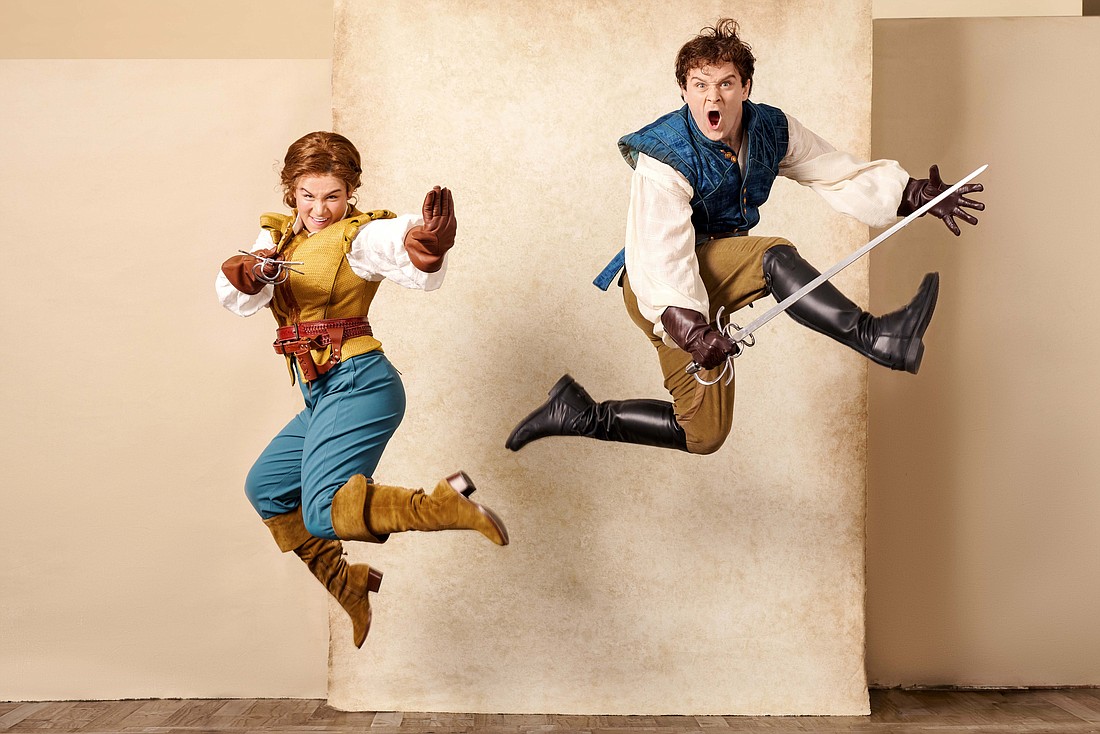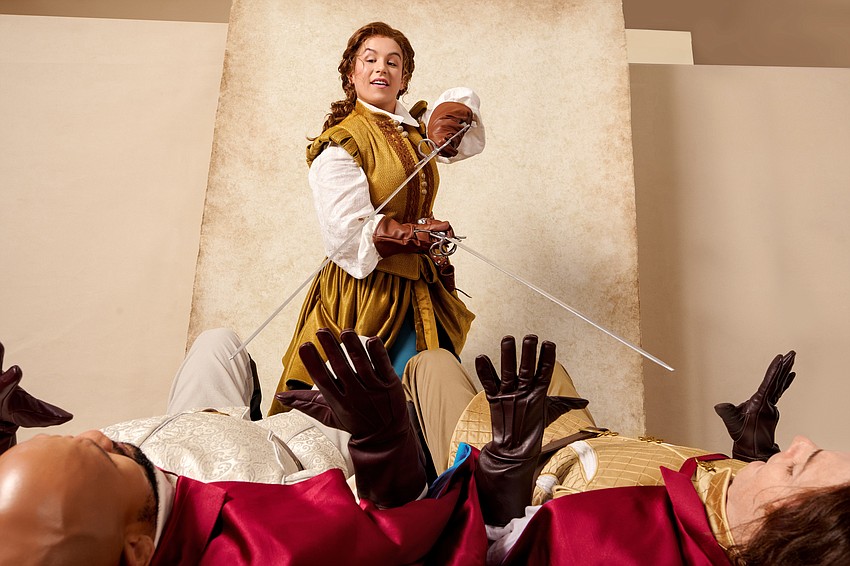- April 10, 2025
-
-
Loading

Loading

Talk about a marriage made in theatrical heaven. Peter Amster gets a kick out of finding a fresh directorial take on the classics. Playwright Ken Ludwig knows exactly how he feels.
In his adaptations, Ludwig lovingly takes well-told tales apart and puts them back together in inventive ways. When the Asolo Repertory Theatre staged Ludwig’s adaptation of “Murder on the Orient Express,” Amster seemed like the ideal director. He was. The talents are joining forces again on Ludwig’s adaptation of “The Three Musketeers.” What to expect?
After scores of stage and screen adaptations, the plot is fairly familiar.
In the 1600s, the Musketeers of the Guard were an elite fighting unit protecting the household of the King of France. D’Artagnan, a young, impressionable country lad, wants to join up and fight evil.
Three of the most formidable Musketeers — namely Athos, Porthos and Aramis — take him under their wing. D’Artagnan winds up fighting evil — in the form of the Machiavellian machinations of Cardinal Richelieu and Milady. It’s more than D’Artagnan bargained for. (And if you think evil wins, you didn’t keep up with your high school reading assignments.)
Ludwig’s adaptation honors the core narrative — in his fast-paced, brainy style, of course. There are witty philosophical clashes worthy of George Bernard Shaw. But it’s not just an intellectual exercise. There’s swashbuckling too, bien sûr. His script is a razor-sharp clash of words and swords.
To do justice to both, we spoke to both the director and fight director Geoffrey Kent. Our first question was pointed …
Even with a witty makeover, why put a tale from 1844 on stage?
“First, because I love it,” Amster says. “For me, ‘The Three Musketeers’ works on so many different levels. It’s an adventure story. It’s a coming-of-age story. More than that, it’s a Bildungsromane — a genre dealing with education for adult life that started in the 19th century. It’s clearly a struggle of good against evil, both personally, and in the realm of politics. It’s a story of friendship, of course — and a celebration of solidarity. ‘All for one and one for all!” is its most famous line — and that’s what it’s all about.”

As Amster sees it, Dumas’ 19th-century novel is packed with good stuff. Ludwig’s 21st century adaptation keeps it all intact. But he adds contemporary elements — and takes it to another level. The director’s favorite upgrade?
He’s happy to see that Ludwig’s “Musketeers” isn’t a boy’s club anymore.
“Ludwig brings in Sabine — D’Artagnan’s sister,” Amster says. “She’s someone with real agency. Without giving away the ending, let’s just say she’s just as much a hero as her brother.”
Sabine tests her mettle in conflict — that’s a basic rule of characterization. In “The Three Musketeers,” she tests it with metal swords. Words can never hurt you — but swords can. How does Kent keep the actors safe?
According to Kent, for staged combat to put the audience on the edge of their seats, it has to look dangerously spontaneous. To avoid any real danger, the fight director rehearses that illusion of spontaneity to the Nth degree. Bottom line?
The swordfights are fake. That’s why they’re safe.
“It’s like a good production of ‘Peter Pan,’” he says. “You know there are wires — but you don’t want to see the wires. Our swordfights should look like reckless abandon. But they’re carefully choreographed — with lots of duplicative safeties the audience can’t see.”
What are “duplicative safeties?” Kent defines them as redundant systems of protection in fight choreography. In his approach, it’s a very long list.
In a play like this, he makes sure the actors have the highest level of training and physical skill — and brings in a few ringers, too. “In a musical, you cast actors who can sing and dance,” he says. “For ‘The Three Musketeers,’ we cast very skilled fighters.”
Kent adds that relentless rehearsal is basic to all staged swordplay. In this production, the swords aren’t actually sharp — and actors wear protective gear. Distance is also important. Swords may clash, but they never touch the actors. What looks like physical contact is an illusion of forced perspective.
According to Kent, theatrical swordplay also reveals character. The way someone fights shows you who they are.
“My job is to create fight choreography the actors can really own,” says Kent. “When we started the process, I asked each actor for a one-word definition of their character’s fighting style,” says Kent. “One said, “effortless.” Another said, “unexpected.” I used these insights to move away from generic swordplay. Not every one fights the same. And not every fight should look the same. One might seem bouncy and fun; another is comic relief; another might seem exhausted. Compared to other shows, ‘The Three Musketeers’ has a lot of action. There are only seven swordfights in the whole production — and they naturally separate into different styles.”
Amster points out that sword fighting is integral, both to Dumas’ original novel and Ludwig’s adaptation. “Ludwig’s version is a comedy — but it’s not just comedy. You care about the characters, and they’re fighting for a cause that matters. There are real stakes — and real danger.”
The director adds that this applies to the real world as well. Which is why Dumas’ tale of friendship, courage and solidarity isn’t a thing of the past.
‘The Three Musketeers’ is a story about working together to achieve something honorable, noble, and for the benefit of all,” Amster says. “It’s about achieving something as a group that you could never accomplish individually. In our current dystopian climate, the lesson of “All for one and one for all” still applies. It may feel like we’re shouting that message into a wind of hatred, distrust and divisiveness. But we’ve got to keep shouting."